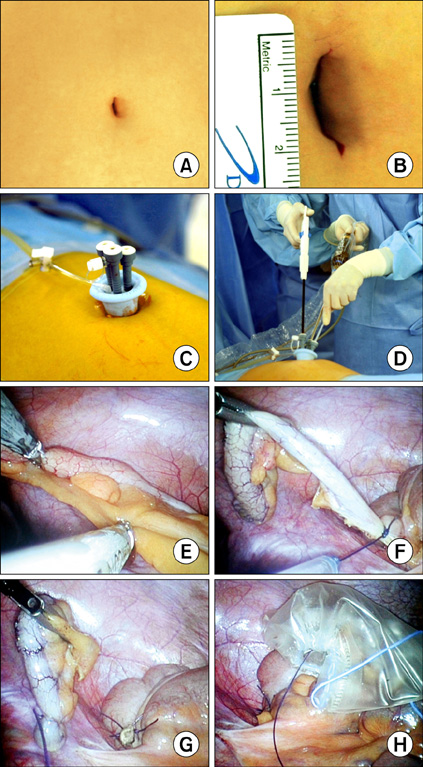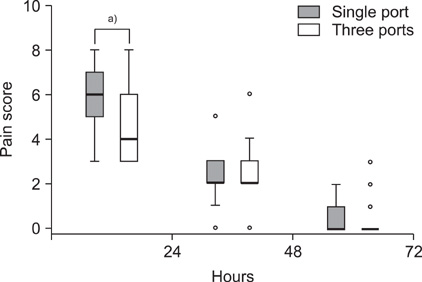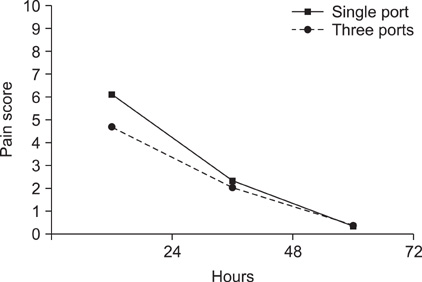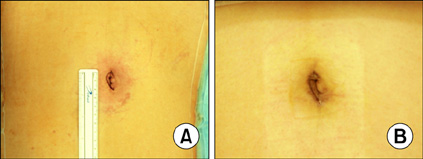J Korean Surg Soc.
2012 Mar;82(3):172-178. 10.4174/jkss.2012.82.3.172.
Pain after laparoscopic appendectomy: a comparison of transumbilical single-port and conventional laparoscopic surgery
- Affiliations
-
- 1Department of Surgery, Kangbuk Samsung Medical Center, Sungkyunkwan University School of Medicine, Seoul, Korea. ch63.yoo@samsung.com
- KMID: 2212219
- DOI: http://doi.org/10.4174/jkss.2012.82.3.172
Abstract
- PURPOSE
Conventional laparoscopic appendectomy is performed using three ports, and single-port appendectomy is an attractive alternative in order to improve cosmesis. The aim of this study was to compare pain after transumbilical single-port laparoscopic appendectomy (SA) with pain after conventional three-port laparoscopic appendectomy (TA).
METHODS
From April to September 2011, 50 consecutive patients underwent laparoscopic appendectomy for simple appendicitis without gangrene or perforation. Patients who had undergone appendectomy with a drainage procedure were excluded. The type of surgery was chosen based on patient preference after written informed consent was obtained. The primary endpoint was postoperative pain evaluated by the visual analogue scale score and postoperative analgesic use. Operative time, recovery of bowel function, and length of hospital stay were secondary outcome measures.
RESULTS
SA using a SILS port (Covidien) was performed in 17 patients. The other 33 patients underwent TA. Pain scores in the 24 hours after surgery were higher in patients who underwent SA (P = 0.009). The change in postoperative pain score over time was significantly different between the two groups (P = 0.021). SA patients received more total doses of analgesics (nonsteroidal anti-inflammatory drugs) in the 24 hours following surgery, but the difference was not statistically significant. The median operative time was longer for SA (P < 0.001).
CONCLUSION
Laparoscopic surgeons should be concerned about longer operation times and higher immediate postoperative pain scores in patients who undergo SA.
MeSH Terms
Figure
Cited by 1 articles
-
Effect of bupivacaine on postoperative pain and analgesics use after single-incision laparoscopic appendectomy: double-blind randomized study
Heon-Kyun Ha, Kyung-Goo Lee, Kang Kook Choi, Wan Sung Kim, Hyung Rae Cho
Ann Surg Treat Res. 2020;98(2):96-101. doi: 10.4174/astr.2020.98.2.96.
Reference
-
1. Tiwari MM, Reynoso JF, Tsang AW, Oleynikov D. Comparison of outcomes of laparoscopic and open appendectomy in management of uncomplicated and complicated appendicitis. Ann Surg. 2011. 254:927–932.2. Wei HB, Huang JL, Zheng ZH, Wei B, Zheng F, Qiu WS, et al. Laparoscopic versus open appendectomy: a prospective randomized comparison. Surg Endosc. 2010. 24:266–269.3. Wei B, Qi CL, Chen TF, Zheng ZH, Huang JL, Hu BG, et al. Laparoscopic versus open appendectomy for acute appendicitis: a metaanalysis. Surg Endosc. 2011. 25:1199–1208.4. Chouillard E, Dache A, Torcivia A, Helmy N, Ruseykin I, Gumbs A. Single-incision laparoscopic appendectomy for acute appendicitis: a preliminary experience. Surg Endosc. 2010. 24:1861–1865.5. Chow A, Purkayastha S, Nehme J, Darzi LA, Paraskeva P. Single incision laparoscopic surgery for appendicectomy: a retrospective comparative analysis. Surg Endosc. 2010. 24:2567–2574.6. Hong TH, Kim HL, Lee YS, Kim JJ, Lee KH, You YK, et al. Transumbilical single-port laparoscopic appendectomy (TUSPLA): scarless intracorporeal appendectomy. J Laparoendosc Adv Surg Tech A. 2009. 19:75–78.7. Kim HJ, Lee JI, Lee YS, Lee IK, Park JH, Lee SK, et al. Single-port transumbilical laparoscopic appendectomy: 43 consecutive cases. Surg Endosc. 2010. 24:2765–2769.8. Lee J, Baek J, Kim W. Laparoscopic transumbilical single-port appendectomy: initial experience and comparison with three-port appendectomy. Surg Laparosc Endosc Percutan Tech. 2010. 20:100–103.9. Lee SY, Lee HM, Hsieh CS, Chuang JH. Transumbilical laparoscopic appendectomy for acute appendicitis: a reliable one-port procedure. Surg Endosc. 2011. 25:1115–1120.10. Lee YS, Kim JH, Moon EJ, Kim JJ, Lee KH, Oh SJ, et al. Comparative study on surgical outcomes and operative costs of transumbilical single-port laparoscopic appendectomy versus conventional laparoscopic appendectomy in adult patients. Surg Laparosc Endosc Percutan Tech. 2009. 19:493–496.11. Ohno Y, Morimura T, Hayashi S. Transumbilical laparoscopically assisted appendectomy in children: the results of a single-port, single-channel procedure. Surg Endosc. 2012. 26:523–527.12. Raakow R, Jacob DA. Initial experience in laparoscopic single-port appendectomy: a pilot study. Dig Surg. 2011. 28:74–79.13. St Peter SD, Adibe OO, Juang D, Sharp SW, Garey CL, Laituri CA, et al. Single incision versus standard 3-port laparoscopic appendectomy: a prospective randomized trial. Ann Surg. 2011. 254:586–590.14. Park JH, Hyun KH, Park CH, Choi SY, Choi WH, Kim DJ, et al. Laparoscopic vs transumbilical single-port laparoscopic appendectomy; results of prospective randomized trial. J Korean Surg Soc. 2010. 78:213–218.15. Vettoretto N, Gobbi S, Corradi A, Belli F, Piccolo D, Pernazza G, et al. Consensus conference on laparoscopic appendectomy: development of guidelines. Colorectal Dis. 2011. 13:748–754.16. Fazili FM, Al-Bouq Y, El-Hassan OM, Gaffar HF. Laparoscope-assisted appendectomy in adults: the two-trocar technique. Ann Saudi Med. 2006. 26:100–104.17. Stanfill AB, Matilsky DK, Kalvakuri K, Pearl RH, Wallace LJ, Vegunta RK. Transumbilical laparoscopically assisted appendectomy: an alternative minimally invasive technique in pediatric patients. J Laparoendosc Adv Surg Tech A. 2010. 20:873–876.18. Cervini P, Smith LC, Urbach DR. The effect of intraoperative bupivacaine administration on parenteral narcotic use after laparoscopic appendectomy. Surg Endosc. 2002. 16:1579–1582.19. Sandeman DJ, Bennett M, Dilley AV, Perczuk A, Lim S, Kelly KJ. Ultrasound-guided transversus abdominis plane blocks for laparoscopic appendicectomy in children: a prospective randomized trial. Br J Anaesth. 2011. 106:882–886.20. Conaghan P, Maxwell-Armstrong C, Bedforth N, Gornall C, Baxendale B, Hong LL, et al. Efficacy of transversus abdominis plane blocks in laparoscopic colorectal resections. Surg Endosc. 2010. 24:2480–2484.
- Full Text Links
- Actions
-
Cited
- CITED
-
- Close
- Share
- Similar articles
-
- Transumbilical Laparoscopic Assisted Single Port Appendectomy (Hybrid Appendectomy) in Children
- A comparison of transumbilical single-port laparoscopic appendectomy and conventional three-port laparoscopic appendectomy: from the diagnosis to the hospital cost
- Transumbilical single port laparoscopic appendectomy using basic equipment: a comparison with the three ports method
- Laparoscopic vs Transumbilical Single-Port Laparoscopic Appendectomy; Results of Prospective Randomized Trial
- A Case of Single Port Laparoscopic Appendectomy and Cholecystectomy in a Fresh Cadaver: A Feasible Procedure





